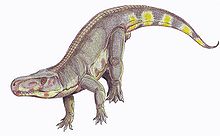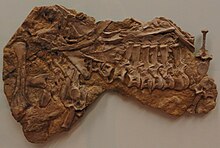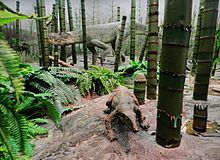Batrachotomus
| Batrachotomus | |
|---|---|

| |
| Reconstructed skeleton, Staatliches Museum für Naturkunde Stuttgart | |
| Scientific classification | |
| Domain: | Eukaryota |
| Kingdom: | Animalia |
| Phylum: | Chordata |
| Class: | Reptilia |
| Clade: | Archosauria |
| Clade: | Pseudosuchia |
| Clade: | Loricata |
| Genus: | †Batrachotomus Gower, 1999 |
| Species: | †B. kupferzellensis
|
| Binomial name | |
| †Batrachotomus kupferzellensis Gower, 1999
| |
Batrachotomus
The locality where Batrachotomus lived was a swampy region and the name comes from the
Description


Batrachotomus was a heavily built, large quadrupedal reptile reaching 6 metres (20 ft) in length. A trait that characterized Batrachotomus, compared to other
Like

Batrachotomus had a tall and narrow skull estimated at 40 to 50 cm (1.3 to 1.6 ft) in length.
The jaws contained sharp teeth which were compressed laterally and unequal in size and shape,
Discovery and history

Remains of Batrachotomus have been found in southern Germany, mainly in the Kupferzell fossil locality in northern Baden-Württemberg. Fossil collector Johann G. Wegele discovered the first specimens in a 1977 excavation at the Erfurt Formation, dated from the Longobardian (late Ladinian) age.[12][13] Other remains attributed to Batrachotomus have been collected in Vellberg-Eschenau, about 10 km east of Schwäbisch Hall, and in Crailsheim. The most notable are from Vellberg-Eschenau, which are represented by well preserved ribs and vertebrae (MHI 1895), and evidence of forelimbs and hindlimbs (SMNS 90018).[13] Batrachotomus today is displayed in the Muschelkalk Museum, Ingelfingen, Stuttgart.
The fossils recovered from a
Classification

Batrachotomus was a prestosuchid, a member of a family of carnivorous archosaurs within the larger group Rauisuchia. The family name "Prestosuchidae" was established in 1966 by American paleontologist Alfred Romer. Prestosuchids were quadrupedal reptiles, medium to large in size, characterized by erect posture, large and narrow skull and large antorbital openings.[16]
Attention was first brought to Batrachotomus in 1993 by
Sterling J. Nesbitt (2011) revised the
The cladogram below follows an analysis by Sterling J. Nesbitt (2011):[23]

Archosauria
|
|
Paleoecology
Since 1977, the rich vertebrate fauna found at Baden-Württemberg reflects a moist region of the Middle Triassic in Germany. Along with Batrachotomus, palaeontologists recovered remains of fishes, amphibians, such as
References
- Notes
- ^ a b Gower (1999), p. 6.
- ^ Gower (1999), p. 1.
- ^ a b c d e f Gower and Schoch (2009), p. 117.
- ^ Gower and Schoch (2009), p. 104.
- ^ Gower and Schoch (2009), p. 109.
- ^ Gower and Schoch (2009), p. 119 (Figure 8).
- ^ a b c d e Gower (1999), p. 7.
- ^ Benton (2005), p. 112.
- ^ a b Gower (1999), p. 37.
- ^ Gower (1999), p. 38.
- ^ Gower (1999), pp. 37–38.
- ^ a b c d Gower (1999), p. 5.
- ^ a b c Gower and Schoch (2009), p. 121.
- ^ a b Gower (2002), p. 49.
- ^ Gower and Schoch (2009), p. 103.
- ^ Sill (1974), p. 317.
- ^ Parrish (1993), p. 301.
- ^ Benton and Walker (2002), pp. 40–41.
- S2CID 83493714.
- S2CID 86797826.
- .
- S2CID 210915628.
- S2CID 83493714.
- ^ Rozynek (2008), p. 4.
- Sources
- ISBN 0-632-05637-1.
- Benton, Michael J.; Walker, Alick D. (2002). "Erpetosuchus, a crocodile-like basal archosaur from the Late Triassic of Elgin, Scotland". Zoological Journal of the Linnean Society. 136 (1): 25–47. .
- Gower, David J. (1999). "The cranial and mandibular osteology of a new rauisuchian archosaur from the Middle Triassic of southern Germany" (PDF). Stuttgarter Beiträge zur Naturkunde B. 280: 1–9.
- Gower, David J. (2002). "Braincase evolution in Suchian Archosaurs (Reptilia: Diapsida): Evidence from the Rauisuchian Batrachotomus kupferzellensis". Zoological Journal of the Linnean Society. 136 (1): 49–76. .
- Gower, David J.; Schoch, Rainer R. (2009). "Postcranial Anatomy of the Rauisuchian Archosaur Batrachotomus kupferzellensis". Journal of Vertebrate Paleontology. 29 (1): 103–122. S2CID 196611289.
- Parrish, J. Michael (1993). "Phylogeny of the Crocodylotarsi, with reference to archosaurian and crurotarsan monophyly". Journal of Vertebrate Paleontology. 13 (3): 287–308. .
- Rozynek, Brigitte (2008). "Schozachia donaea n. gen., n. sp., a new cycad megasporophyll from the Middle Triassic (Ladinian) of Southern Germany". Palaeodiversity. 1. Stuttgart: 1–17.
- Sill, William D. (1974). "The anatomy of Saurosuchus galilei and the relationships of the rauisuchid thecodonts". Bulletin Museum of Comparative Zoology, Harvard. 146: 317–362.
External links
- (in English) Batrachotomus at palaeos.com.
- (in German) Der "Lurchenschlächter" Batrachotomus at bestiarium.kryptozoologie.net.
